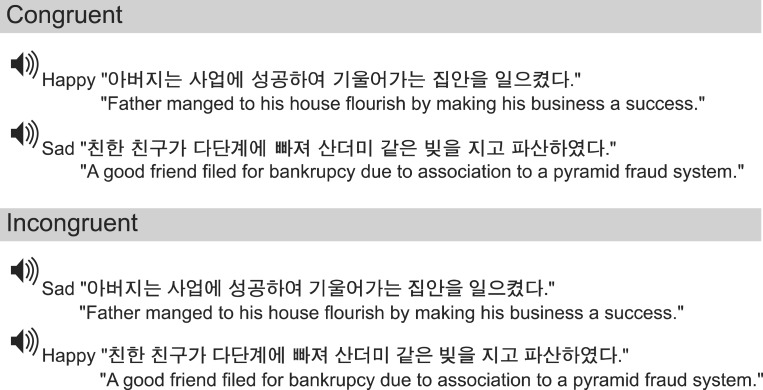Ann Rehabil Med.
2013 Oct;37(5):642-648. 10.5535/arm.2013.37.5.642.
Prosody Processing of Korean Language in Stroke Patients: A Preliminary Study
- Affiliations
-
- 1Department of Rehabilitation, National Rehabilitation Center, Seoul, Korea. asfreelyas@gmail.com
- 2Department of Psychiatry, Asan Medical Center, University of Ulsan College of Medicine, Seoul, Korea.
- 3Department of Psychiatry, University of Ulsan College of Medicine, Seoul, Korea.
- KMID: 2266581
- DOI: http://doi.org/10.5535/arm.2013.37.5.642
Abstract
OBJECTIVE
To investigate the hemispheric contributions to prosody recognitions and interference effects of semantic processing on prosody for stroke patients by using the Korean language.
METHODS
Ten right hemisphere damaged patients (RHD), nine left hemisphere damaged patients (LHD), and eleven healthy controls (HC) participated. In pure prosody recognition task, four semantically neutral sentences were selected and presented in both sad and happy prosodies. In interference task, participants listened to emotionally intoned sentences in which the semantic contents were congruent or incongruent with prosody. Participants were asked to rate the valence of prosody while ignoring the semantic contents, and thus, reaction time and accuracy were estimated.
RESULTS
In pure prosody recognition task, RHD showed low accuracy as compared to HC (p=0.013), and the tendency of group response showed that RHD performed worse than HC and LHD with regards to accuracy and reaction time. In interference task, analysis of accuracy revealed a significant main effect of groups (p=0.04), and the tendency implied that RHD is less accurate as compared to LHD and HC. The RHD took longer reaction times than HC in congruent and incongruent items (p<0.001).
CONCLUSION
Right hemispheric laterality to prosody processing of Korean language in stroke patients was observed. Interference effects of semantic contents to prosody processing were not observed, which suggested unique characteristics of prosody for Korean language. These results could be referred as preliminary data for future researches on Korean languages.
MeSH Terms
Figure
Reference
-
1. Heilman KM, Scholes R, Watson RT. Auditory affective agnosia: disturbed comprehension of affective speech. J Neurol Neurosurg Psychiatry. 1975; 38:69–72. PMID: 1117301.
Article2. Monrad-Krohn GH. Dysprosody or altered melody of language. Brain. 1947; 70:405–415. PMID: 18903253.
Article3. Ross ED. The aprosodias: functional-anatomic organization of the affective components of language in the right hemisphere. Arch Neurol. 1981; 38:561–569. PMID: 7271534.4. Ley RG, Bryden MP. A dissociation of right and left hemispheric effects for recognizing emotional tone and verbal content. Brain Cogn. 1982; 1:3–9. PMID: 6927552.
Article5. Paulmann S, Kotz SA. An ERP investigation on the temporal dynamics of emotional prosody and emotional semantics in pseudo- and lexical-sentence context. Brain Lang. 2008; 105:59–69. PMID: 18177699.
Article6. Buchanan TW, Lutz K, Mirzazade S, Specht K, Shah NJ, Zilles K, et al. Recognition of emotional prosody and verbal components of spoken language: an fMRI study. Brain Res Cogn Brain Res. 2000; 9:227–238. PMID: 10808134.
Article7. Gandour J, Wong D, Dzemidzic M, Lowe M, Tong Y, Li X. A cross-linguistic fMRI study of perception of intonation and emotion in Chinese. Hum Brain Mapp. 2003; 18:149–157. PMID: 12599272.
Article8. George MS, Parekh PI, Rosinsky N, Ketter TA, Kimbrell TA, Heilman KM, et al. Understanding emotional prosody activates right hemisphere regions. Arch Neurol. 1996; 53:665–670. PMID: 8929174.
Article9. Kotz SA, Meyer M, Alter K, Besson M, von Cramon DY, Friederici AD. On the lateralization of emotional prosody: an event-related functional MR investigation. Brain Lang. 2003; 86:366–376. PMID: 12972367.
Article10. Pell MD. Cerebral mechanisms for understanding emotional prosody in speech. Brain Lang. 2006; 96:221–234. PMID: 15913754.
Article11. Friederici AD, Alter K. Lateralization of auditory language functions: a dynamic dual pathway model. Brain Lang. 2004; 89:267–276. PMID: 15068909.
Article12. Mitchell RL, Elliott R, Barry M, Cruttenden A, Woodruff PW. The neural response to emotional prosody, as revealed by functional magnetic resonance imaging. Neuropsychologia. 2003; 41:1410–1421. PMID: 12757912.
Article13. Woldorff MG, Gallen CC, Hampson SA, Hillyard SA, Pantev C, Sobel D, et al. Modulation of early sensory processing in human auditory cortex during auditory selective attention. Proc Natl Acad Sci U S A. 1993; 90:8722–8726. PMID: 8378354.
Article14. Kitayama S, Ishii K. Word and voice: spontaneous attention to emotional utterances in two languages. Cogn Emot. 2002; 16:29–59.
Article15. Ishii K, Reyes JA, Kitayama S. Spontaneous attention to word content versus emotional tone: differences among three cultures. Psychol Sci. 2003; 14:39–46. PMID: 12564752.16. Peron J, El Tamer S, Grandjean D, Leray E, Travers D, Drapier D, et al. Major depressive disorder skews the recognition of emotional prosody. Prog Neuropsychopharmacol Biol Psychiatry. 2011; 35:987–996. PMID: 21296120.17. Schlipf S, Batra A, Walter G, Zeep C, Wildgruber D, Fallgatter A, et al. Judgment of emotional information expressed by prosody and semantics in patients with unipolar depression. Front Psychol. 2013; 4:461. PMID: 23888149.
Article18. Schirmer A, Kotz SA. ERP evidence for a sex-specific stroop effect in emotional speech. J Cogn Neurosci. 2003; 15:1135–1148. PMID: 14709232.
Article19. Paulmann S, Pell MD, Kotz SA. How aging affects the recognition of emotional speech. Brain Lang. 2008; 104:262–269. PMID: 17428529.
Article
- Full Text Links
- Actions
-
Cited
- CITED
-
- Close
- Share
- Similar articles
-
- Comparison of Speech Perception Performance According to Prosody Change Between People With Normal Hearing and Cochlear Implant Users
- An Implementation of Natural Language Processing and Text Mining in Stroke Research
- Network Analysis of Language Disorganization in Patients with Schizophrenia
- Aphasia and the Diagram Makers Revisited: an Update of Information Processing Models
- Current Approaches to the Treatment of Post-Stroke Aphasia





